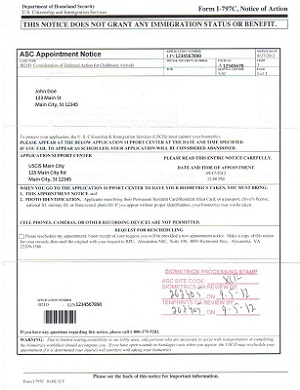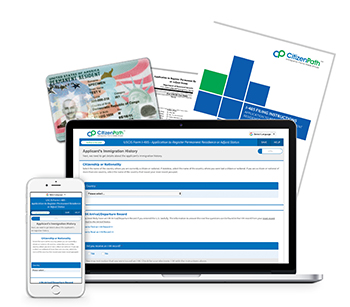What to Expect at a USCIS Biometric Appointment
Biometrics Appointment Explained
What is a biometric screening?
When you apply for a benefit from U.S. Citizenship and Immigration Services (USCIS) — such as a work permit, citizenship, green card or even a green card renewal — a standard part of the process is a biometrics appointment (also known as a biometrics screening). It may sound scary, but most people shouldn’t be concerned. Regardless, it's important to understand what happens at your USCIS appointment, what to expect, and who should be concerned.
The technical definition of “biometrics” means that a person’s unique physical and other traits are detected and recorded as a means of confirming identity. In simple terms, USCIS will obtain your photograph, fingerprints and have you sign your name. This process confirms your identity so that USCIS provides benefits to the correct person and facilitates the necessary criminal background check. USCIS will submit your biometrics to the FBI for the criminal background check. They will not draw blood nor will they gather DNA for the purposes of DNA testing. A biometrics screening is not an interview. Therefore, you can expect this process to be quick. You don’t have to bring any payment with you to the biometrics appointment if you have already paid the biometrics fee(s) with your application (this is usually the case).
Application Support Center (ASC) Appointment Notice
Where will my biometrics appointment be?
USCIS will mail you the biometrics appointment notice after you submit your application or petition. The appointment will take place before you receive any benefits or a card in the mail. The letter will arrive as an "Application Support Center (ASC) Appointment Notice" (Form I-797C, Notice of Action) and will include information about the date, time and location for your ASC appointment. The appointment itself takes most people 15 to 30 minutes.
Appointment Location
USCIS recommends that you attend the biometrics appointment at the Application Support Center that has been scheduled for you. If the location of this ASC is not convenient for you, some applicants have been able to reschedule the appointment at an alternative ASC. A change in location is at the discretion of USCIS. For a list of ASCs, see the USCIS Service and Office Locator.
Again, USCIS will schedule the time and location for you. USCIS recommends that you appear at the ASC which has been assigned to you. If you are outside the United States, the appointment will be at a U.S. embassy or consulate near you.

Biometric Notice Codes
You may notice that your ASC Biometrics Appointment Notice includes a code in the top right part of the letter. The code indicates the type of biometrics processing to be performed. The possible values are:
- Code 1 – The appointment is limited to collecting fingerprints for all 10 digits. USCIS forwards the fingerprints to the FBI for a background check.
- Code 2 – Personnel will collect a photo, signature and index finger press print. This type of processing is typical for beneficiaries who receive a card like a permanent resident card or employment authorization document (EAD).
- Code 3 – Personnel will collect a photo, signature, index finger press print, as well as fingerprints for all 10 digits. Code 3 is a combination of Codes 1 and 2.
Rescheduling a Biometrics Appointment
Can I reschedule biometrics?
You may reschedule a USCIS biometric appointment if absolutely necessary. However, you should expect a reschedule to significantly delay your overall processing time. USCIS generally recommends that you attend the appointment that they schedule for you. If you must reschedule, be prepared to establish that you have "good cause."
Good Cause to Reschedule
Good cause exists where the request to reschedule provides a sufficient reason for the benefit requestor’s inability to appear on the scheduled appointment date. According to USCIS, sufficient reasons for “good cause” may include, but are not limited to:
- Illness, medical appointment, or hospitalization;
- Previously planned travel;
- Significant life events such as a wedding, funeral, or graduation ceremony;
- Inability to obtain transportation to the appointment location;
- Inability to obtain leave from employment or caregiver responsibilities; and
- Late delivered or undelivered biometric services appointment notice.
How to Reschedule
If you are unable to attend a biometrics appointment and can establish good cause for rescheduling, use the USCIS website to reschedule the appointment online. To use the biometric services appointment rescheduling tool, you must first create a USCIS online account (if you do not already have one) and visit my.uscis.gov before your scheduled appointment date. You must:
- Select the Biometric Rescheduling option;
- Follow the on-screen instructions to reserve a new appointment time and/or appointment location;
- Choose a method (email or SMS message) to receive a confirmation message once a printable copy of the new appointment notice is available; and
- Print the new appointment notice to bring to the application support center (ASC).
If you are unable to reschedule your biometrics appointment online, call USCIS at 1-800-375-5283 (TTY 1-800-767-1833) before the date and time of your original appointment.
If you fail to request a new appointment before your scheduled appointment or fail to establish good cause, USCIS may not reschedule the appointment. If you fail to appear for your originally scheduled biometric services appointment and the appointment is not rescheduled, they will consider the related application, petition, or request abandoned and, as a result, USCIS may deny it. USCIS no longer accepts written requests to reschedule the appointment.
Rescheduling your appointment will delay your case. It is likely that USCIS will deny the application or petition you filed if biometrics is not satisfied within a reasonable time frame. Therefore, it's generally best to complete the biometrics screening as soon as possible.
Items to Take to Your Biometrics Appointment
What should I take to the appointment?
When you get your biometric services appointment notification, it will include a list of items to take to the appointment. In addition to the appointment notice itself (Form I-797C), you must take government-issued photo identification. Typically, acceptable documents include:
- Permanent resident card (green card)
- Passport or national photo identification issued by your home country
- Driver’s license
- Military photo identification
- State-issued photo identification card
When you appear for your biometrics appointment, USCIS will digitally capture your fingerprints, photograph and signature on a LiveScan machine. When it is time to sign your name, USCIS will ask you to attest to the truth of the following statement:
They will only display the statement in the English or Spanish languages. If you require a different language, USCIS recommends that you select the appropriate language translation and review it before you appear for your ASC appointment.
When to Be Concerned About a Biometrics Appointment
When should I be worried?
Most people don't need to worry about the USCIS biometrics appointment and subsequent FBI background check. USCIS will process this information through the FBI database in order to check for any criminal records.
However, if you think you might have a criminal record or past immigration violations, contact an immigration lawyer before going to a USCIS biometrics appointment. (If you think you might have a criminal record, you should contact an immigration lawyer before filing any USCIS form.) Certain criminal offenses will make you ineligible for immigration benefits and can even trigger removal proceedings. A lawyer can request a background check before USCIS does and deal with it as necessary.
After the Biometric Appointment
What happens after this appointment?
Before you leave the biometrics appointment, personnel should provide a stamp on your appointment notice confirming that you attended. Keep this document safe. It serves as proof if USCIS cannot find its record stating that you attended the appointment.
The next step depends on the type of application or petition you filed. Some, like marriage cases, require an interview. Other cases, such as employment-based petitions, may only require interviews when there are issues that need further inquiry.
If you get another biometrics appointment notice in the following weeks, don’t panic. This is usually the result of smudged prints, and fingerprints will need to be retaken to complete the background check. USCIS will not charge an additional fee.
Depending on your application type and the service center processing it, it may be several weeks (or months) before you hear from USCIS again. Remember, you can always check the status of your case online.
How CitizenPath Helps You Prepare USCIS Forms
Why do people use CitizenPath?
CitizenPath's affordable, online service makes it easy to prepare USCIS applications and petitions. Designed by immigration lawyers, the service helps you eliminate the common errors that create delays, rejections and even denials. That's because the service alerts you when your answer to a question may be a problem. You'll also get customized filing instructions based on your situation. It's a powerful, do-it-yourself tool that puts you in control. And we've got your back -- CitizenPath provides live customer support and provides a money-back guarantee that USCIS will approve the form.

